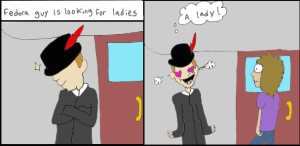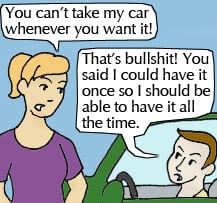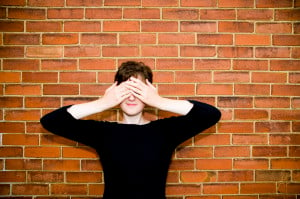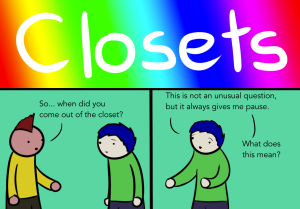A month ago, I cried for the seventh time this year.
I was preparing to give a keynote, and I desperately needed my eyebrows arched. I looked up places in my small, Central Californian town and found one with great reviews on Yelp.
I called to schedule an appointment and the woman responded, “Sorry, ladies only. ”
A flood of anxiety and self-loathing filled me to tears. To know that my voice, isolated from my body, marked me as male was soul crushing.
It took me thirty minutes to muster the courage to call another place, hoping for more inclusivity and welcome.
Later that day, while trying to get my nails done, I had a similarly crushing experience.
After the salon manager gave me so many uncomfortable looks, smacked me on the back, and called me trouble, I found myself humiliated, rushing to pay, ruining my fresh nails, and falling to tears for the eighth time.
I know that some of you are probably wondering why I would react so intensely to what might seem like no big deal or minuscule, even, to larger systems of oppression.
But for trans women, who spend a lifetime having the authenticity of our very identity and existence questioned and rejected over and over and over again, these experiences are often life threatening and play a significant role in creating an unsafe world for us.
We are denied access to various women’s spaces, like nail and hair salons, political movements, support groups, and bathrooms. And all of these exclusions are based on a simple transmisogynist idea – that trans women aren’t women.
The glares and whispers in a nail salon let us know we’re not welcome. That covert rejection creates intense anxiety to the extent where, my close trans women friends and I who aren’t read as cis women, often don’t go to women’s spaces alone.
Sometimes we’re incredibly isolated and don’t leave our homes for fear of public scrutiny and shouted (or whispered) insults.
There’s also the life-risking endangerment when we are denied critical resources such as shelters, domestic violence advocacy, and healthcare.
These larger structures greatly impact our livelihoods and expose many trans women, particularly Black trans women who are targeted and surveillanced by the State, to violence.
Imagine not being able to access healthcare. I don’t mean exclusively hormone replacement therapy. I’m talking about any healthcare.
Trans women, either because of their income or discomfort with being misgendered by healthcare providers, often avoid going to the doctor.
This barrier to healthcare is a reason why we are at the highest risk of contracting HIV.
Out of the 191 new diagnoses of HIV among transgender people in New York from 2007-2011, 99% of them were trans women – and 90% of those women were Black and/or Latina.
Since many of us have a current or previous history of sex work, contracting HIV could mean the loss of steady income. If you lose your job and your housing, and shelters aren’t safe or welcoming to you, what do you do?
We take to living on the streets and somehow make ends meet. While this isn’t something that is comfortable to acknowledge, it’s absolutely critical in order to ensure the safety and well-being for all trans women.
Fortunately, there’s been traction within the feminist movement to be more critical of transmisogyny.
We now have enough visibility and support to write our own books, host our own news segments, and star in television series. This has led to many conversations between trans women and cis women to build solidarity.
This also means that the language around trans women is constantly evolving.
However, there are still a few terms that are used with good intentions that have seriously dire consequences.
Here’s a list of three common mistakes well-meaning feminist make when trying to be supportive of trans women:
1. Female-Bodied or Female-Identified
The idea of a female body, when used in writing or political spaces, is usually assumed to be a cis woman’s body.
There is no singular female body, and even though feminist movements are broadening the idea of a woman’s body to include bigger, disabled, Black and brown women, they are not doing justice to trans women’s bodies.
People use “female-bodied” to talk about people assigned female at birth, which completely erases trans women’s bodies that are female.
This is a step towards unlearning that penises equates to maleness. That our breasts, whether flat or hormone-grown or implanted, are our breasts and just as natural as any other breast.
Not recognizing our bodies as naturally female supports a patriarchal culture that defines what a woman’s body is.
It’s not that we want to be perceived as cis women. It’s that we want safety from this transmisogynist society – which, until more is done to include and protect us, means being perceived as cis.
It means seeking resources from medical industries that consider our surgeries “cosmetic,” when, in reality, we are just trying to stay alive.
Ideally, a trans woman is inherently a woman and no one questions her. In some small pockets of transfeminist communities, this is true. But in the larger feminist movement, not so much.
Female-identified is another phrase that subtly supports the idea that we aren’t women.
This is usually used to be inclusive with the thought being “If you identify yourself as a female, you can be in this space.” Except, do cis women have to exert their womanhood as often as we do? No, not nearly so.
The solution is simple: Advertise that your space is for “trans and cis women,” and we will all come.
An ally action is to explain that it’s necessary to name the type of women at this event, just as one may do for an event that’s centering women of color, disabled women, and so on.
You don’t need to make us invisible to keep us safe. We need to be named and openly supported in women’s spaces.
If you want to ensure trans women feel safe, have openly trans women working in the space. Part of this is extending beyond theory into practice.
Instead of saying trans women are welcome to an event run by cis women, have actual trans women in leadership positions to create the events that center and support us. Be someone who offers resources and support to allow us to develop our own women’s spaces.
That’s the kind of solidarity that truly makes social change.
2. Wombyn or Womyn
“Wombyn” is used to describe a woman with a womb, essentially marking a cis woman. This separation from women to women-who-have-wombs is a gender-policing step that excludes trans women from womanhood.
Let’s dig a little deeper on this one.
This hyperfocus on a womb makes many trans and cis women uncomfortable.
This idea that a womb is the life-sustaining holy grail that embodies femininity and womanhood is one that often fuels reproductive rights opposition.
A woman is forced to believe her duty in life is to bear children to a man is in the same vein that a trans woman who can’t birth a child is not a true woman.
Both of these patriarchal views of women’s bodies deny us agency. Both of these views believe there is an authority over what women’s bodies must (re)produce.
Whether a woman has a womb or not, her womanhood shouldn’t be dependent on what she produces.
As feminist women, we should strive to see the common ground and listen to each other to be in solidarity. I’m asking that you see my womb-less body as valid, just as I see you as valid whether or not you choose to bear children.
“Womyn” was created to de-center “man” from the spelling of woman. It was a feminist and political move to create spaces that focused on women’s issues. In theory, this is a great idea!
However, the implementation hasn’t been so great since trans women are misgendered as men very often in feminist and political spaces. Most trans women I know are wary of spaces labeled “womyn” because we know that we are misunderstood as men.
This creates unsafe and exclusionary women’s spaces, and no one wants that, right?
…except, sometimes they do.
Take the Michigan’s Womyn Festival for example. They’re celebrating their 40th anniversary this upcoming August and yet, they are still exclusionary to trans women after being called out multiple times.
They state on their website they’re going to “celebrate our living legacy of badass females coming together for four decades – to build community, to recharge our energies, renew faded inspiration and to sit in the source of our collective power.”
In four decades, we’ve had Laverne Cox create a documentary about CeCe McDonald’s wrongful imprisonment for self-defense against a white supremacist, which is building off of Miss Major’s ongoing work to support trans prisoners at the Transgender, Gender Variant, and Intersex Justice Project (TGIJP).
We also have Janet Mock’s beautifully vulnerable and critical memoir, Redefining Realness, that brought survival sex work, child sexual abuse, and mixed-race identity issues to national light by making it to the New York Times’ Best Seller’s List.
These legacies have shaped and continue to shape liberation for all women. However, the Michigan’s Womyn Festival doesn’t recognize our lives or contributions as valuable.
This is what transmisogyny is within feminist communities – where our genders are invalidated by the policing of what women’s bodies and experiences should be, instead of embracing them for what they are.
3. Male and Female Socialization
This is a theoretical framework that’s reared its confused head the past few years to talk about how people are taught gender roles and expectations.
There’s an assertion that people assigned female at birth have female socialization and therefore know what it’s like to be a woman. Conversely, people assigned male at birth have male socialization and know what it’s like to be a man.
When it comes to trans women, cis women have made the claim that we have male socialization, which equates to having male privilege.
Simply put, you must be male to benefit from male privilege. Trans women aren’t male, so we don’t benefit from male privilege and never have.
Our gender is called into question as soon as we start exhibiting behavior that is not white heteropatriarchy masculinity. This can be in early childhood, adolescence, or adulthood.
Even when we are socially perceived as male, we are experiencing a misgendering and invisiblizing violence and are subject to vital danger when we assert our gender identity.
This is what transmisogyny is – a conditional safety that, no matter how cis appearing we are, often results in death.
This male and female socialization is used to further distance cis women from trans women. Cis women were raised to cook, clean, smile, endure sexual harassment, be silently ashamed about their menstrual cycles, and prioritize child bearing and marriage.
These are the supposed commonalities that bind cis women together as shared experiences that trans women don’t have.
The truth is, as b. binaohan states in the “fe/male socialization” chapter of decolonizing trans/gender 101, we all have the same socialization.
Through our growing processes, everyone is taught what boys are like and what girls are like. This is how we distinguish ourselves from the other.
As a young trans girl child, I was told not to place my hands on my hips, to sit up straighter, to stop “crying like a girl,” that playing with dolls is a “girl thing.”
I understood, just as much as cis women, what the standards were for being a girl – and I was punished if I behaved in those manners.
***
Yes, it is true that cis and trans women have different experiences. Our womanhoods are vastly different.
I know the stakes of being a trans woman are higher in terms of extreme violence, death, and suicide (and again, we’re barred from accessing critical resources for women, thus leaving us more vulnerable).
This is the current reality of being a trans woman because of decades of semantics that have stated we are mentally ill, perverts, monsters, and child molesters.
While these paradigms are shifting, there is still a lot of work to be done to unlearn the misconceptions about us.
Every step we take to reinforce that trans women are women and female, trans women’s experiences are women’s experiences, we are keeping the momentum of this paradigm shifting and creating a more just, safe, loving world for trans women.
Part of it is learning to be intentional about language; another part is having a love and courage strong enough to protect us when moving through public spaces.
My cis women friends have learned how to listen to my experiences and validate what doesn’t reflect their own without any qualifications.
They are often protective and righteously angry when we go to women’s spaces and I’m mistreated.
This is the kind of supportive world I live in most of the time, and I’m hoping this helps others learn how to create this for their own communities.
[do_widget id=”text-101″]
Luna Merbruja is a Contributing Writer for Everyday Feminism. She’s the author of Trauma Queen, an intern at Biyuti Publishing, international sorceress of performance art, and co-coordinator of the 2014 International Trans Women of Color Network Gathering. She’s currently working towards her career as a sex and trauma therapist.
Search our 3000+ articles!
Read our articles about:
Our online racial justice training
Used by hundreds of universities, non-profits, and businesses.
Click to learn more





















